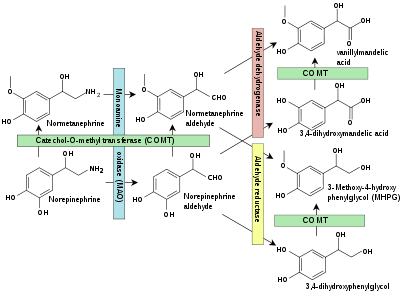Metanephrine
Metanephrine is the name given to two methylation products of the catecholamines adrenaline , metanephrine , and noradrenaline , normetanephrine . Both substances arise from their predecessors through the action of the enzyme catechol-O-methyltransferase (COMT), whereby the configuration is retained. Some of them are excreted directly in the urine as conjugates , the other part is further deaminated to 3-methoxy-4-hydroxymandelic acid aldehyde by means of the enzyme monoamine oxidase (MAO), which then in a further step either oxidizes to vanillin almond acid (VMS) or to 3- Methoxy-4-hydroxyphenylglycol (MHPG, MOPEG) is reduced, which are then also excreted in the urine.
Racemic metanephrine is produced synthetically, the hydrochloride has the CAS number 881-95-8.
Representative
| Metanephrine | ||||
| Surname | Metanephrine | Normetanephrine | ||
| other names | 3-methoxyadrenaline | 3-methoxynoradrenaline | ||
| Structural formula |

|

|
||
| CAS number |
|
|
||
| PubChem | 21100 | 1237 | ||
| Molecular formula | C 10 H 15 NO 3 | C 9 H 13 NO 3 | ||
| Molar mass | 197.23 g · mol -1 | 183,20 g · mol -1 | ||
|
GHS labeling
|
Hydrochloride
|
Hydrochloride
|
||
| H and P phrases | 315-319-335 | 315-319-335 | ||
| no EUH phrases | no EUH phrases | |||
| 261-305 + 351 + 338 | 261-305 + 351 + 338 | |||
effect
Metanephrines are the direct inactive metabolites of adrenaline or noradrenaline and no longer have any hormonal effects.
Significance as a tumor marker
A pathologically increased concentration of metanephrines can, among other things, indicate a pheochromocytoma , but it can also be caused by stress. Metanephrines are determined if an adrenaline or noradrenaline-producing tumor is suspected, whereby the catecholamines or (earlier) vanillic almond acid can also be determined directly for diagnosis.
Determination in urine or blood plasma
To determine the metanephrine in the urine , the patient collects his urine for a day (24-hour urine collection ) in a collection vessel provided with hydrochloric acid. The actual determination is then carried out using high-performance liquid chromatography (HPLC) or direct chemical detection methods. New determination methods work directly with blood plasma and thus avoid the cumbersome and error-prone collection of urine.
literature
- Georg Löffler, Petro E. Petrides: Biochemistry and Pathobiochemistry. 7th, completely revised edition. Springer, Berlin et al. 2003, ISBN 3-540-42295-1 , pp. 857-859.
Individual evidence
- ↑ Data sheet DL-Metanephrine hydrochloride from Sigma-Aldrich , accessed on May 5, 2011 ( PDF ).
- ↑ Data sheet Normetanephrine hydrochloride from Sigma-Aldrich , accessed on May 5, 2011 ( PDF ).
- ↑ Figure 11-4 in: Rod Flower, Humphrey P. Rang, Maureen M. Dale, James M. Ritter,: Rang & Dale's pharmacology . Churchill Livingstone, 6th edition. Edinburgh 2007, ISBN 0-443-06911-5 .
- ↑ Biochemical Diagnosis of Pheochromocytoma (PDF; 134 kB).
- ↑ Determination of metanephrines in urine ( Memento from November 9, 2005 in the Internet Archive )

